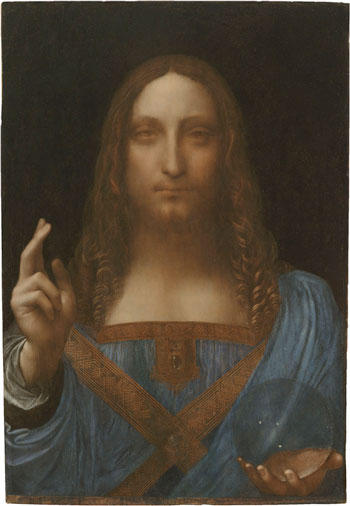Art in America magazine has a scoop: Dallas Museum of Art Director Max Anderson apparently wants to buy the Leonardo, Salvator Mundi, that has resurfaced over the last year and was exhibited at the National Gallery of London’s Leonardo da Vinci: Painter at the Court of Milan last year.Â
 The price tag would be about $200 million.
The price tag would be about $200 million.
According to the article, published online:
Jill Bernstein, the museum’s chief communications officer, confirmed to A.i.A., “We have brought Leonardo da Vinci’s recently re-discovered masterpiece Salvator Mundi (Savior of the World) to the DMA. We are actively exploring the possibility of acquiring it.” Measuring about 26 by 18 inches, the painting shows Christ holding a glass orb in his left hand, with his right hand raised in benediction.
Anderson sees the painting as a “destination painting,” the story notes. And who wouldn’t? Only one other painting by Leonardo is on public view in the United States — Ginevra de’ Benci, which is in the National Gallery of Art, in Washington, D.C.
Where will Dallas get the money? And is the painting worth $200 million, given its condition? It was heavily overpainted and then cleaned too aggressively.
Some of Leonardo’s hand is evident, however, in the orb and the raised hand, and people may well flock to see the picture.
UPDATE: Robert Simon, one of the dealers who is handling the painting, sends a statement about the “overcleaning” remarks made by some people:
There is no doubt that the painting had been heavily overpainted — probably in the seventeenth century. That is essentially the reason why Leonardo’s authorship was not recognized until recently. But the statement that the painting was cleaned too aggressively is misleading. As Dianne Modestini (who cleaned and restored the Salvator Mundi) indicated in public presentations given at the Leonardo conference held at the National Gallery in January and at the Institute of Fine Arts in February (and soon to be published), damage to the painting was largely limited to the narrow areas along two very old cracks in the panel –neither of which go through the head of Christ. While there was localized paint loss there and some scattered abrasions elsewhere, the paint surface of the painting remarkably retains much of its original glazing — a fact confirmed by recent technical analyses. The removal of overpaint in the recent cleaning was undertaken delicately and at the highest level of conservation standards.
